|
|
| Sei in: Cinema e Medioevo ® Indice alfabetico dei film |
Il racconto dei racconti - Tale of Tales
2015, regia di Matteo Garrone
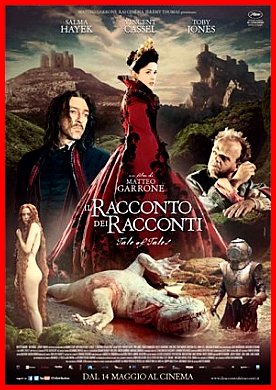
Scheda: Nazione: Italia-Francia-GB - Produzione: Rai Cinema, Archimede, Le Pacte (in associazione con HanWay Films, New Sparta Films, Recorded Picture Company) - Distribuzione: 01 Distribution, Le Pacte, Front Row Filmed Entertainment - Soggetto: da Lo cunto de li cunti overo lo trattenemiento de peccerille, di Giambattista Basile - Sceneggiatura: Edoardo Albinati, Ugo Chiti e Massimo Gaudioso, Matteo Garrone - Fotografia: Peter Suschitzky - Montaggio: Marco Spoletini - Art Direction: Marco Furbatto, Massimo Pauletto, Gianpaolo Rifino - Scenografia: Dimitri Capuan - Set Decoration: Alessia Anfuso - Costumi: Massimo Cantini Parrini - Musiche: Alexandre Desplat - Effetti speciali: Leonardo Cruciano Workshop - Formato: Color - Durata: 125'.
Cast: Salma Hayek, John C. Reilly, Christian Lees, Jonah Lees, Alba Rohrwacher, Vincent Cassel, Renato Scarpa, Massimo Ceccherini, Laura Pizzirani, Franco Pistoni, Giselda Volodi, Giuseppina Cervizzi, Jessie Cave, Toby Jones, Bebe Cave, Guillaume Delaunay, Eric MacLennan, Nicola Sloane, Vincenzo Nemolato, Giulio Beranek, Davide Campagna, Shirley Henderson, Hayley Carmichael, Stacy Martin, Kathryn Hunter, Ryan McParland, Kenneth Collard.
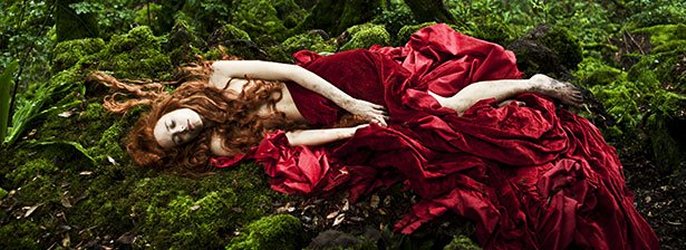
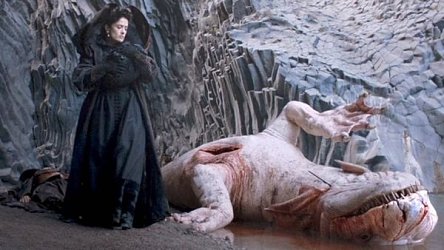
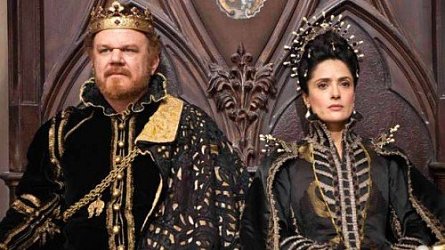
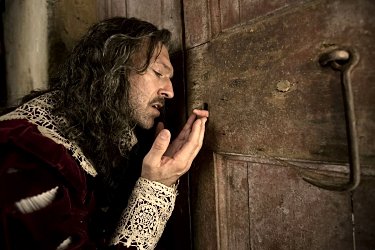
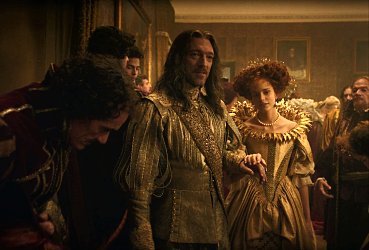
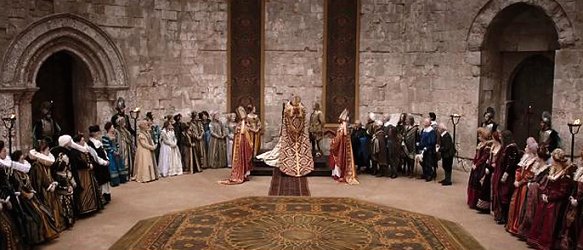
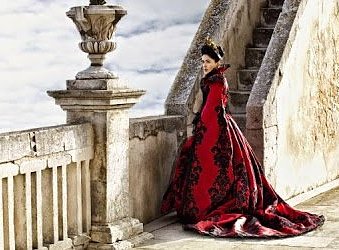
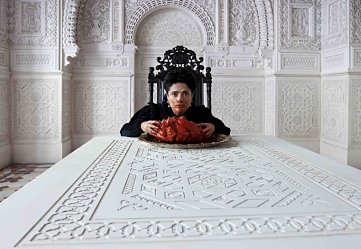
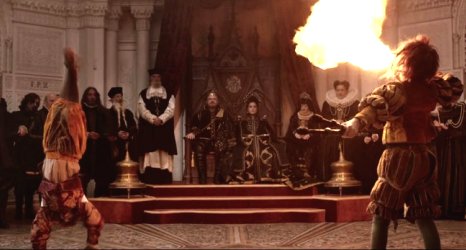
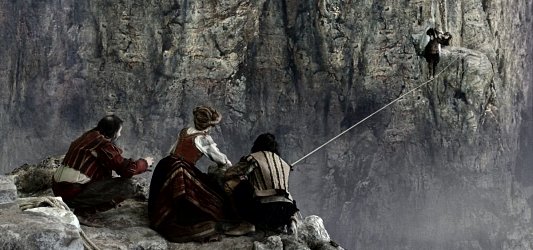
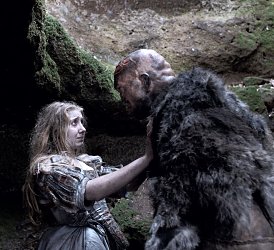
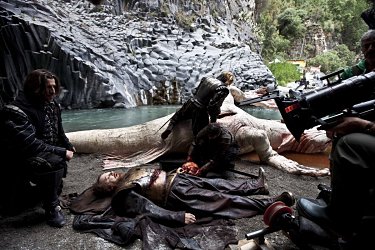
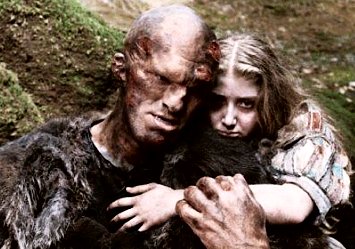
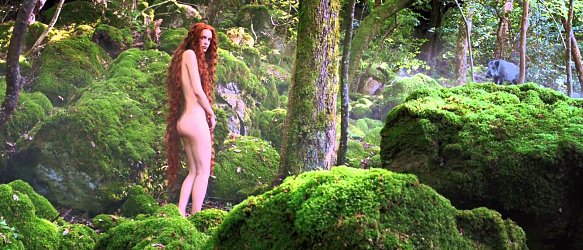
![]() Trama e commenti:
it.wikipedia.org -
quinlan.it -
linkinmovies.it -
ondacinema.it -
comingsoon.it
-
cinefilos.it
-
movieplayer.it
-
filmitalia.org
-
mymovies.it: «1600. Una regina non
riesce più a sorridere, consumata dal desiderio di quel figlio che non arriva.
Due anziane sorelle fanno leva su un equivoco per attirare le attenzioni di un
re erotomane sempre affamato di carne fresca. Un sovrano organizza un torneo per
dare in sposa la figlia contando sul fatto che nessuno dei pretendenti supererà
la prova da lui ideata, così la figlia non lascerà il suo fianco e i confini
angusti del loro castello. Matteo Garrone attinge a piene mani, e con grande
libertà creativa, a tre racconti de Lo cunto de li cunti, la raccolta di
fiabe più antica d'Europa, scritta fra il 1500 e il 1600 in lingua napoletana da
Giambattista Basile. Il risultato è un caleidoscopio di immagini potenti ed
evocative, ma anche un carnevale di umani sentimenti, pulsioni e crudeltà,
nonché una riflessione profondissima sulla natura dell'amore, che può (dovrebbe)
essere dono e che invece, per quelle fiere che sono (ancora) gli esseri umani, è
spesso soprattutto cupidigia. Ognuna delle vicende singolarmente narrate
contiene qualcosa di ognuna delle altre: un doppio, un riflesso, una citazione,
uno scambio di sguardi. La brama con cui la regina vuole per sé (e solo per sé)
un figlio annulla il sacrificio del marito e soffoca il desiderio di essere
amato (per sé) del nuovo nato, che una volta cresciuto incontra il suo "gemello"
più povero ma infinitamente più libero. La lascivia insaziabile del re
erotomane, archetipo pre-dongiovannesco, è una sfida inesauribile alla morte e
alla decadenza del corpo, così ben incarnata (perché di carne, pelle e sangue
sempre si parla ne Il racconto dei racconti) dalle due anziane sorelle
impegnate in una corsa a ritroso nel tempo che finirà per dividerle, "separando
ciò che è inseparabile": come l'unione fra i due "gemelli" dell'episodio
precedente, come il legame fra un padre immeritevole e una figlia degna di
ereditare un regno nell'episodio successivo. La struttura circolare della
narrazione è, a tutti gli effetti, olistica (anche perché guidata da figure
femminili), il che è particolarmente sorprendente perché i tre episodi sono
stati girati separatamente, e non c'è stato tempo, né denaro, per effettuare il
consueto lavoro di rifinitura cui Garrone è abituato. Ma la tessitura
dell'arazzo era già insita nella scrittura (degli sceneggiatori Edoardo Albinati,
Ugo Chiti e Massimo Gaudioso, oltre allo stesso Garrone, ma ancora prima di
Basile) e nell'immaginario cinematografico e pittorico del regista, che
ripropone temi a lui cari - la trasformazione del corpo, la passione accecante,
l'inganno - attraverso la codifica narrativa archetipale della fiaba e la
crittografia visiva del genere fantasy, usato ad altezza autoriale senza
dimenticare il pop delle sue origini e dei suoi intenti. ...» (Paola
Casella).
Trama e commenti:
it.wikipedia.org -
quinlan.it -
linkinmovies.it -
ondacinema.it -
comingsoon.it
-
cinefilos.it
-
movieplayer.it
-
filmitalia.org
-
mymovies.it: «1600. Una regina non
riesce più a sorridere, consumata dal desiderio di quel figlio che non arriva.
Due anziane sorelle fanno leva su un equivoco per attirare le attenzioni di un
re erotomane sempre affamato di carne fresca. Un sovrano organizza un torneo per
dare in sposa la figlia contando sul fatto che nessuno dei pretendenti supererà
la prova da lui ideata, così la figlia non lascerà il suo fianco e i confini
angusti del loro castello. Matteo Garrone attinge a piene mani, e con grande
libertà creativa, a tre racconti de Lo cunto de li cunti, la raccolta di
fiabe più antica d'Europa, scritta fra il 1500 e il 1600 in lingua napoletana da
Giambattista Basile. Il risultato è un caleidoscopio di immagini potenti ed
evocative, ma anche un carnevale di umani sentimenti, pulsioni e crudeltà,
nonché una riflessione profondissima sulla natura dell'amore, che può (dovrebbe)
essere dono e che invece, per quelle fiere che sono (ancora) gli esseri umani, è
spesso soprattutto cupidigia. Ognuna delle vicende singolarmente narrate
contiene qualcosa di ognuna delle altre: un doppio, un riflesso, una citazione,
uno scambio di sguardi. La brama con cui la regina vuole per sé (e solo per sé)
un figlio annulla il sacrificio del marito e soffoca il desiderio di essere
amato (per sé) del nuovo nato, che una volta cresciuto incontra il suo "gemello"
più povero ma infinitamente più libero. La lascivia insaziabile del re
erotomane, archetipo pre-dongiovannesco, è una sfida inesauribile alla morte e
alla decadenza del corpo, così ben incarnata (perché di carne, pelle e sangue
sempre si parla ne Il racconto dei racconti) dalle due anziane sorelle
impegnate in una corsa a ritroso nel tempo che finirà per dividerle, "separando
ciò che è inseparabile": come l'unione fra i due "gemelli" dell'episodio
precedente, come il legame fra un padre immeritevole e una figlia degna di
ereditare un regno nell'episodio successivo. La struttura circolare della
narrazione è, a tutti gli effetti, olistica (anche perché guidata da figure
femminili), il che è particolarmente sorprendente perché i tre episodi sono
stati girati separatamente, e non c'è stato tempo, né denaro, per effettuare il
consueto lavoro di rifinitura cui Garrone è abituato. Ma la tessitura
dell'arazzo era già insita nella scrittura (degli sceneggiatori Edoardo Albinati,
Ugo Chiti e Massimo Gaudioso, oltre allo stesso Garrone, ma ancora prima di
Basile) e nell'immaginario cinematografico e pittorico del regista, che
ripropone temi a lui cari - la trasformazione del corpo, la passione accecante,
l'inganno - attraverso la codifica narrativa archetipale della fiaba e la
crittografia visiva del genere fantasy, usato ad altezza autoriale senza
dimenticare il pop delle sue origini e dei suoi intenti. ...» (Paola
Casella).
![]() Plot Summary, Synopsis, Review: IMDb
-
eyeforfilm.co.uk
-
littlewhitelies.co.uk
-
thefilmstage.com
-
theupcoming.co.uk
-
movies.ie
-
deadline.com
-
plumenoire.com
-
filmstarts.de
-
cine-vue.com:
«Once upon a time, fairytales were folk tales. Then they became children's
stories. Then they became Disney cartoons and now they star Angelina Jolie or
Charlize Theron. Into the woods (and in competition at the Cannes Film Festival)
strides Matteo Garrone's Tale of Tales (2015), an anthology of 17th
century folk tales by Giambattista Basile told with a verve and commitment to
the strange. Best known for his neo-neo-realism with such films as the Naples
based gangland drama Gomorrah (which showed in the Un Certain Regard
sidebar in 2008) and Reality, which showed in competition in 2012,
Tale of Tales is Garrone's first feature in English, but in a way the film is
in an older language. Three neighbouring kingdoms are ruled by three troubled
monarchs. A Queen (Salma Hayek) will do anything to have a child - no matter
what devil's bargain she must strike or what her doting king (John C. Reilly)
must sacrifice. A lecherous king - Vincent Cassel luxuriantly robed in his best
self-parody - is unsated by his own bloated appetites and in pursuit of an
unobtainable and unseen village beauty whose singing enraptures him. The final
king (Toby Jones) dotes on his daughter but finds himself distracted by a new
insect pet which grows to gigantic Kafkaesque proportions. This is a magical
world of transformations, witches, ogres, princesses, acrobats and clowns, but
there is very little chance of a happily ever after and Garrone consistently
eschews both a Disneyfied sentiment and a more complex and darker post-modern
retelling. In fact, in stark contrast to such Hollywood re-imagining ... Garrone
takes the stories at their original meaning. His film is neither post-modern nor
even modern. It's medieval. With starkly enigmatic, but beautifully wrought and
filigree imagery, with a dark cutting humour which is bleak rather than ironic,
Garrone is not interested in touching our hearts or giving us a comfortable
moral. Rather his fables scrape bare human weakness and reveal the cruelty and
the cost that must be paid. Consequences are laid out by a grim reaper like
figure, who turns up at the court assuring the royals that a price must be paid.
Deals are made with eyes open and the universe is an unforgiving place. ... As
with Pasolini, so Garrone glancingly re-appropriates short form literature, to
provide an intertwining narrative that is cruel hopefully to be kind, cutting
short ambition and declaring all is vanity, vanity, vanity. There is also a wit
here which sees the most outrageous allegory brought down to earth. The presence
of recognisable Hollywood stars such as Reilly, albeit fleeting, indicates a
hankering for a mainstream audience. But in reality (whatever that is) Garrone's
film is defiantly odd, consistently striking and often luminous. The score by
the prolific Alexandre Desplat pounds ominously through the film like the
knocking of fate on the castle door and the photography by Peter Suschitzky
manages to capture the intimacy of lived reality in the nowhere of a fabled time
as well as some of the most luscious natural locations. The castles, the stone
labyrinth and the green woods are gorgeously portrayed. Mythical beasts might be
conquered and women thrown from windows, but something ultimately survives and
Garrone's Tale of Tales has images which live on long after the closing
credits have run» (John Bleasdale).
Plot Summary, Synopsis, Review: IMDb
-
eyeforfilm.co.uk
-
littlewhitelies.co.uk
-
thefilmstage.com
-
theupcoming.co.uk
-
movies.ie
-
deadline.com
-
plumenoire.com
-
filmstarts.de
-
cine-vue.com:
«Once upon a time, fairytales were folk tales. Then they became children's
stories. Then they became Disney cartoons and now they star Angelina Jolie or
Charlize Theron. Into the woods (and in competition at the Cannes Film Festival)
strides Matteo Garrone's Tale of Tales (2015), an anthology of 17th
century folk tales by Giambattista Basile told with a verve and commitment to
the strange. Best known for his neo-neo-realism with such films as the Naples
based gangland drama Gomorrah (which showed in the Un Certain Regard
sidebar in 2008) and Reality, which showed in competition in 2012,
Tale of Tales is Garrone's first feature in English, but in a way the film is
in an older language. Three neighbouring kingdoms are ruled by three troubled
monarchs. A Queen (Salma Hayek) will do anything to have a child - no matter
what devil's bargain she must strike or what her doting king (John C. Reilly)
must sacrifice. A lecherous king - Vincent Cassel luxuriantly robed in his best
self-parody - is unsated by his own bloated appetites and in pursuit of an
unobtainable and unseen village beauty whose singing enraptures him. The final
king (Toby Jones) dotes on his daughter but finds himself distracted by a new
insect pet which grows to gigantic Kafkaesque proportions. This is a magical
world of transformations, witches, ogres, princesses, acrobats and clowns, but
there is very little chance of a happily ever after and Garrone consistently
eschews both a Disneyfied sentiment and a more complex and darker post-modern
retelling. In fact, in stark contrast to such Hollywood re-imagining ... Garrone
takes the stories at their original meaning. His film is neither post-modern nor
even modern. It's medieval. With starkly enigmatic, but beautifully wrought and
filigree imagery, with a dark cutting humour which is bleak rather than ironic,
Garrone is not interested in touching our hearts or giving us a comfortable
moral. Rather his fables scrape bare human weakness and reveal the cruelty and
the cost that must be paid. Consequences are laid out by a grim reaper like
figure, who turns up at the court assuring the royals that a price must be paid.
Deals are made with eyes open and the universe is an unforgiving place. ... As
with Pasolini, so Garrone glancingly re-appropriates short form literature, to
provide an intertwining narrative that is cruel hopefully to be kind, cutting
short ambition and declaring all is vanity, vanity, vanity. There is also a wit
here which sees the most outrageous allegory brought down to earth. The presence
of recognisable Hollywood stars such as Reilly, albeit fleeting, indicates a
hankering for a mainstream audience. But in reality (whatever that is) Garrone's
film is defiantly odd, consistently striking and often luminous. The score by
the prolific Alexandre Desplat pounds ominously through the film like the
knocking of fate on the castle door and the photography by Peter Suschitzky
manages to capture the intimacy of lived reality in the nowhere of a fabled time
as well as some of the most luscious natural locations. The castles, the stone
labyrinth and the green woods are gorgeously portrayed. Mythical beasts might be
conquered and women thrown from windows, but something ultimately survives and
Garrone's Tale of Tales has images which live on long after the closing
credits have run» (John Bleasdale).
![]() Approfondimenti: Movie
Review
Approfondimenti: Movie
Review